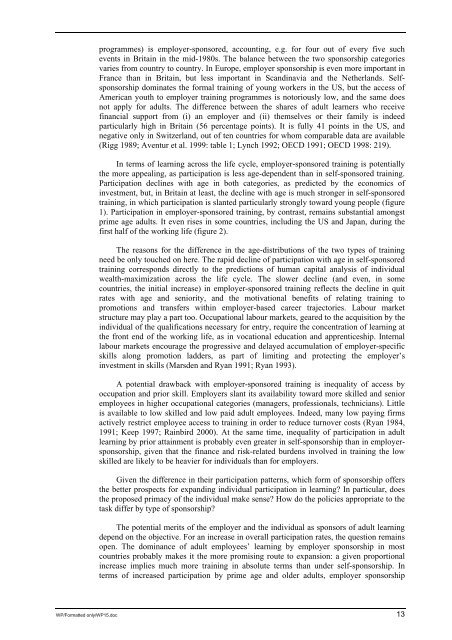Lifelong learning - International Labour Organization
Lifelong learning - International Labour Organization
Lifelong learning - International Labour Organization
You also want an ePaper? Increase the reach of your titles
YUMPU automatically turns print PDFs into web optimized ePapers that Google loves.
programmes) is employer-sponsored, accounting, e.g. for four out of every five such<br />
events in Britain in the mid-1980s. The balance between the two sponsorship categories<br />
varies from country to country. In Europe, employer sponsorship is even more important in<br />
France than in Britain, but less important in Scandinavia and the Netherlands. Selfsponsorship<br />
dominates the formal training of young workers in the US, but the access of<br />
American youth to employer training programmes is notoriously low, and the same does<br />
not apply for adults. The difference between the shares of adult learners who receive<br />
financial support from (i) an employer and (ii) themselves or their family is indeed<br />
particularly high in Britain (56 percentage points). It is fully 41 points in the US, and<br />
negative only in Switzerland, out of ten countries for whom comparable data are available<br />
(Rigg 1989; Aventur et al. 1999: table 1; Lynch 1992; OECD 1991; OECD 1998: 219).<br />
In terms of <strong>learning</strong> across the life cycle, employer-sponsored training is potentially<br />
the more appealing, as participation is less age-dependent than in self-sponsored training.<br />
Participation declines with age in both categories, as predicted by the economics of<br />
investment, but, in Britain at least, the decline with age is much stronger in self-sponsored<br />
training, in which participation is slanted particularly strongly toward young people (figure<br />
1). Participation in employer-sponsored training, by contrast, remains substantial amongst<br />
prime age adults. It even rises in some countries, including the US and Japan, during the<br />
first half of the working life (figure 2).<br />
The reasons for the difference in the age-distributions of the two types of training<br />
need be only touched on here. The rapid decline of participation with age in self-sponsored<br />
training corresponds directly to the predictions of human capital analysis of individual<br />
wealth-maximization across the life cycle. The slower decline (and even, in some<br />
countries, the initial increase) in employer-sponsored training reflects the decline in quit<br />
rates with age and seniority, and the motivational benefits of relating training to<br />
promotions and transfers within employer-based career trajectories. <strong>Labour</strong> market<br />
structure may play a part too. Occupational labour markets, geared to the acquisition by the<br />
individual of the qualifications necessary for entry, require the concentration of <strong>learning</strong> at<br />
the front end of the working life, as in vocational education and apprenticeship. Internal<br />
labour markets encourage the progressive and delayed accumulation of employer-specific<br />
skills along promotion ladders, as part of limiting and protecting the employer’s<br />
investment in skills (Marsden and Ryan 1991; Ryan 1993).<br />
A potential drawback with employer-sponsored training is inequality of access by<br />
occupation and prior skill. Employers slant its availability toward more skilled and senior<br />
employees in higher occupational categories (managers, professionals, technicians). Little<br />
is available to low skilled and low paid adult employees. Indeed, many low paying firms<br />
actively restrict employee access to training in order to reduce turnover costs (Ryan 1984,<br />
1991; Keep 1997; Rainbird 2000). At the same time, inequality of participation in adult<br />
<strong>learning</strong> by prior attainment is probably even greater in self-sponsorship than in employersponsorship,<br />
given that the finance and risk-related burdens involved in training the low<br />
skilled are likely to be heavier for individuals than for employers.<br />
Given the difference in their participation patterns, which form of sponsorship offers<br />
the better prospects for expanding individual participation in <strong>learning</strong>? In particular, does<br />
the proposed primacy of the individual make sense? How do the policies appropriate to the<br />
task differ by type of sponsorship?<br />
The potential merits of the employer and the individual as sponsors of adult <strong>learning</strong><br />
depend on the objective. For an increase in overall participation rates, the question remains<br />
open. The dominance of adult employees’ <strong>learning</strong> by employer sponsorship in most<br />
countries probably makes it the more promising route to expansion: a given proportional<br />
increase implies much more training in absolute terms than under self-sponsorship. In<br />
terms of increased participation by prime age and older adults, employer sponsorship<br />
WP/Formatted only/WP15.doc 13

















